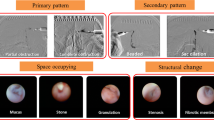Abstract
Backgrounds
To evaluate the effectiveness of simultaneous medial spindle procedure (MS) and/or lateral tarsal strip procedure (TS) with an endonasal dacryocystorhinostomy (DCR) for treatment of involutional medial punctal ectropion, horizontal eyelid laxity, and nasolacrimal duct obstruction.
Methods
We conducted a retrospective, interventional study of DCR performed from March 2009 to July 2011 by a single surgeon (Baek SH). Patient age, sex, results of medial and lateral distraction test, surgical procedure, time of tube removal, duration of follow-up, functional and anatomical success rate, and causes of failed surgeries were recorded. Lateral lower eyelid laxity was evaluated by a medial distraction test, and medial lid laxity was evaluated by a lateral distraction test.
Results
A total of 241 eyes in 175 patients were included in this study. The proportion of combined surgeries to total DCR was 24.5 % (59 of 241 eyes). DCR and MS (D + M) were performed on 23 eyes in 17 patients (9.5 %) and DCR and TS (D + T) on 29 eyes in 17 patients (12.0 %). Concurrent DCR, MS and TS (D + M + T) were performed on seven eyes in four patients (2.9 %). Mean age was significantly higher in the combined surgery groups (63.8 ± 10.0 years) than in the DCR group (56.2 ± 10.6 years; p = 0.01, by Mann–Whitney U test). The anatomical success rates were 84.2 % in D, 86.9 % in D + M, 89.5 % in D + T, and 85.7 % in D + M + T (p = 0.61 by Kruskal–Wallis test). Functional success rates were 82.4 % in D, 86.9 % in D + M, 86.2 % in D + T, and 85.7 % in D + M + T (p = 0.91 by Kruskal–Wallis test).
Conclusions
MS and TS performed concurrently with a DCR may be an effective tool to deal with epiphora due to complex clinical situations such as nasolacrimal duct obstruction, lid laxity, and involutional medial ectropion. It is recommended to examine punctum and lid laxity carefully using slit-lamp biomicroscopy and lid distraction test in patients with epiphora, especially in elderly patients.





Similar content being viewed by others
References
Linberg JV, McCormick SA (1986) Primary acquired nasolacrimal duct obstruction. A clinicopathologic report and biopsy technique. Ophthalmology 93:1055–1063
Hurwitz JJ (1996) The lacrimal system. Lippincott-Raven, Philadelphia
Calkins LL (1964) Lids, lacrimal apparatus, and conjunctiva. Arch Ophthalmol 71:131–143
Werb A (1964) Surgery of epiphora. Int Ophthalmol Clin 4:377–397
Detorakis ET, Drakonaki E, Papadaki E, Pallikaris IG, Tsilimbaris MK (2010) Watery eye following patent external DCR: an MR dacryocystography study. Orbit 29:239–243
Bergeron CM, Moe KS (2008) The evaluation and treatment of lower eyelid paralysis. Facial Plast Surg 24:231–241. doi:10.1055/s-2008-1075839
Salvi SM, Akhtar S, Currie Z (2006) Ageing changes in the eye. Postgrad Med J 82:581–587
Liu D, Stasior OG (1983) Lower eyelid laxity and ocular symptoms. Am J Ophthalmol 95:545–551
Narayanan K, Barnes EA (2005) Epiphora with eyelid laxity. Orbit 24:201–203
Fong KC, Mavrikakis I, Sagili S, Malhotra R (2006) Correction of involutional lower eyelid medial ectropion with transconjunctival approach retractor plication and lateral tarsal strip. Acta Ophthalmol Scand 84:246–249
Nowinski TS, Anderson RL (1985) The medial spindle procedure for involutional medial ectropion. Arch Ophthalmol 103:1750–1753
Nerad J (2010) Techniques in ophthalmic plastic surgery. Elsevier Saunders, Philadelphia, pp 270–272
Anderson RL, Gordy DD (1979) The tarsal strip procedure. Arch Ophthalmol 97:2192–2196
Olver JM, Sathia PJ, Wright M (2001) Lower eyelid medial canthal tendon laxity grading: an interobserver study of normal subjects. Ophthalmology 108:2321–2325
TE Lee LH, Lee JM, Park M, Baek S (2011) Medial and lateral canthal tendon laxity: an evaluation of patients with involutional entropion and epiphora. J Korean Ophthalmol Soc 52(12):1385–1390
Munk PL, Lin DT, Morris DC (1990) Epiphora: treatment by means of dacryocystoplasty with balloon dilation of the nasolacrimal drainage apparatus. Radiology 177:687–690
Jordan DR, Anderson RL (1989) The lateral tarsal strip revisited. The enhanced tarsal strip. Arch Ophthalmol 107:604–606
Becker BB (1992) Tricompartment model of the lacrimal pump mechanism. Ophthalmology 99:1139–1145
Hill JC, Bethell W, Smirmaul HJ (1974) Lacrimal drainage—a dynamic evaluation. Part I—mechanics of tear transport. Can J Ophthalmol J Can Ophtalmol 9:411–416
Hill JC, Bethell W, Smirmaul HJ (1974) Lacrimal drainage—a dynamic evaluation. Part II—clinical aspects. Can J Ophthalmol J Can Ophtalmol 9:417–424
Smith B (1976) The “lazy-T” correction of ectropion of the lower punctum. Arch Ophthalmol 94:1149–1150
Tsirbas A, Wormald PJ (2003) Endonasal dacryocystorhinostomy with mucosal flaps. Am J Ophthalmol 135:76–83
Kakizaki H, Zako M, Miyaishi O, Nakano T, Asamoto K, Iwaki M (2005) The lacrimal canaliculus and sac bordered by the Horner’s muscle form the functional lacrimal drainage system. Ophthalmology 112:710–716
Heindl LM, Junemann AG, Kruse FE, Holbach LM (2010) Tumors of the lacrimal drainage system. Orbit 29:298–306
Collin J (1989) Manual of systematic eyelid surgery. Churchill Livingstone, Edinburgh
Shorr N, Goldberg RA, Eshaghian B, Cook T (2003) Lateral canthoplasty. Ophthal Plast Reconstr Surg 19:345–352
Vick VL, Holds JB, Hartstein ME, Massry GG (2004) Tarsal strip procedure for the correction of tearing. Ophthal Plast Reconstr Surg 20:37–39
Kielhorn I, Rowson NJ (2002) Lateral canthal surgery in the management of epiphora. Orbit 21:111–116
Conflict of interest
The authors had no conflict of interest.
The authors have no financial interests in the publication of this manuscript.
Author information
Authors and Affiliations
Corresponding author
Rights and permissions
About this article
Cite this article
Lee, H., Lee, JS., Chang, M. et al. The effectiveness of simultaneous medial spindle and/or lateral tarsal strip procedure in East Asian patients who need endonasal dacryocystorhinostomy. Graefes Arch Clin Exp Ophthalmol 251, 2789–2796 (2013). https://doi.org/10.1007/s00417-013-2476-3
Received:
Revised:
Accepted:
Published:
Issue Date:
DOI: https://doi.org/10.1007/s00417-013-2476-3




